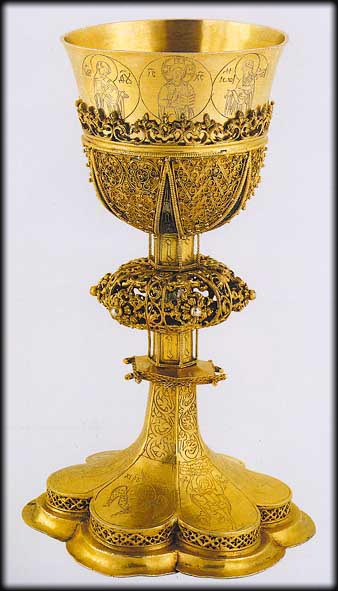 The Holy Grail is one of the most difficult objects to discuss because its nature, meaning and purpose vary from writer to writer and from time to time.
The Holy Grail is one of the most difficult objects to discuss because its nature, meaning and purpose vary from writer to writer and from time to time.The Holy Grail has been part of the western European Christian tradition since the late 12th and early 13th centuries when it was first mentioned by a Cistercian named Helinandus (d. c.1230) who repeats the account of vision of a hermit in c.717 AD during which he was shown the dish used by Jesus Christ at the Last Supper. The origin and subsequent development of the Grail story is important for to the later understanding, and 'placement', of the tale within the chronology from its' inception to the present day. The first and most important point here is that the Grail was first mentioned in an allusion to an event (the 'vision') which allegedly occurred 500 years previously. In other words Helinandus was not recording known or accepted fact.
The Grail, Holy Grail, Greal, Graal, etc. is the name given to a legendary sacred vessel, variously identified with the chalice of the Eucharist or the dish of the Pascal lamb, and the theme of a famous medieval cycle of romance. In the romances the conception of the Grail varies considerably; its nature is often but vaguely indicated, and, in the case of Chrestien's Perceval poem, it is left wholly unexplained.
The meaning of the word has also been variously explained. The generally accepted meaning is that is given by the Cistercian chronicler Helinandus (d. about 1230), who, under the date of about 717, mentions of a vision, shown to a hermit concerning the dish used by Our Lord at the Last Supper, and about which the hermit then wrote a Latin book called "Gradale." "Now in French," so Helinandus informs us, "Gradalis or Gradale means a dish (scutella), wide and somewhat deep, in which costly viands are wont to be served to
 the rich in degrees (gradatim), one morsel after another in different rows. In popular speech it is also called "greal" because it is pleasant (grata) and acceptable to him eating therein" etc. The medieval Latin word "gradale" because in Old French "graal," or "greal," or "greel," whence the English "grail." Others derive the word from "garalis" or from "cratalis" (crater, a mixing bowl). It certainly means a dish, the derivation from "grata" in the latter part of the passage cited above or from "agréer" (to please) in the French romances is secondary. The explanation of "San greal" as "sang real" (kingly blood) was not current until the later Middle Ages. Other etymologies that have been advanced may be passed over as obsolete.
the rich in degrees (gradatim), one morsel after another in different rows. In popular speech it is also called "greal" because it is pleasant (grata) and acceptable to him eating therein" etc. The medieval Latin word "gradale" because in Old French "graal," or "greal," or "greel," whence the English "grail." Others derive the word from "garalis" or from "cratalis" (crater, a mixing bowl). It certainly means a dish, the derivation from "grata" in the latter part of the passage cited above or from "agréer" (to please) in the French romances is secondary. The explanation of "San greal" as "sang real" (kingly blood) was not current until the later Middle Ages. Other etymologies that have been advanced may be passed over as obsolete.When we come to examine the literary tradition concerning the Grail we notice at the outset that the Grail legend is closely connected with that of Perceval as well as that of King Arthur. Yet all these legends were originally independent of each other. The Perceval story may have a mythical origin, or it may be regarded as the tale of a simpleton (Fr., nicelot) who, however, in the end achieves great things. In all the versions that we have of it, it is a part of of the Arthurian legend, and, in almost all, it is furthermore connected with the Grail. So the reconstruction of the original Grail legend can be accomplished only by an analytical comparison of all extant versions, and is a task that has given rise to some of the most difficult problems in the whole range of literary history.
The great body of the Grail romances came into existence between the years 1180 and 1240. After the thirteenth century nothing new was added to the Grail legend. Most of these romances are in French, but there are versions in German, English, Norwegian, Italian, and Portuguese. These are of very unequal value as sources, some are mere translations or recasts of French romances. Now all of these romances may be conveniently divided into two classes: those which are concerned chiefly with the quest of the Grail, and with the adventures and personality of the hero of this quest; and those that are mainly concerned with the history of the sacred vessel itself. These two classes have been styled respectively the Quest and the Early History versions.
Of the first class is the "Conte del Graal" of Chrestien de Troyes and his continuators, a vast poetic compilation of some 60,000 verses, composed between 1180 qnd 1240, and the Middle High German epic poem "Parzival" of Wolfram von Eschenbach, written between 1205 and 1215, and based, according to Wolfram's statement, on the French poem of a certain Kyot (Guiot) of Provence, which, however, is not extant and the very existence of which is doubtful. To these may be added the Welsh folk-tales or
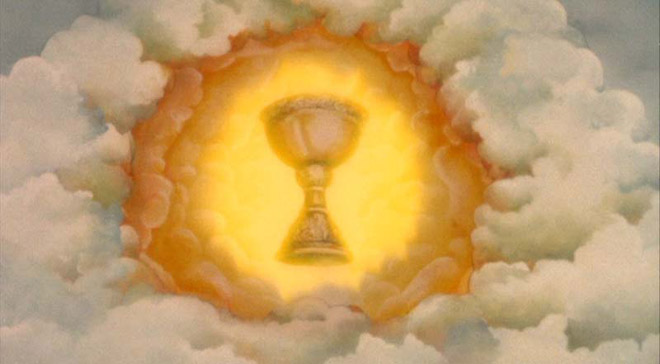 "Mabinogion" known to us only from manuscripts of the thirteenth century, though the material is certainly older, and the English poem "Sir Percyvelle," of the fifteenth century. Of the Early History versions the oldest is the metrical trilogy of Robert de Boron, composed between 1170 and 1212, of which only the first part, the "Joseph d'Arimathie," and a portion of the second, the "Merlin," are extant. We have, however, a complete prose version, preserved in the so-called Didot manuscript. The most detailed history of the Grail is in the "Grand St. Graal," a bulky French prose romance of the first half of the thirteenth century, where we are told that Christ Himself presented to a pious hermit the book concerning this history. Besides these versions we have three French prose romances, also from the thirteenth century, which, though concerned chiefly with the quest, give also an account of the history of the sacred vessel. Of these the most notable is the "Queste del St. Graal," well known to English readers because it was enbodied almost entire in Malory's "Morte d' Arthur." The others are the so-called "Didot Perceval" or "La petite queste" and the lengthy and prolix "Perceval le Gallois," also known as "Perlesvaus."
"Mabinogion" known to us only from manuscripts of the thirteenth century, though the material is certainly older, and the English poem "Sir Percyvelle," of the fifteenth century. Of the Early History versions the oldest is the metrical trilogy of Robert de Boron, composed between 1170 and 1212, of which only the first part, the "Joseph d'Arimathie," and a portion of the second, the "Merlin," are extant. We have, however, a complete prose version, preserved in the so-called Didot manuscript. The most detailed history of the Grail is in the "Grand St. Graal," a bulky French prose romance of the first half of the thirteenth century, where we are told that Christ Himself presented to a pious hermit the book concerning this history. Besides these versions we have three French prose romances, also from the thirteenth century, which, though concerned chiefly with the quest, give also an account of the history of the sacred vessel. Of these the most notable is the "Queste del St. Graal," well known to English readers because it was enbodied almost entire in Malory's "Morte d' Arthur." The others are the so-called "Didot Perceval" or "La petite queste" and the lengthy and prolix "Perceval le Gallois," also known as "Perlesvaus."The poem of Chrestien, regarded by many as the oldest known Grail romance, tells of Perceval's visit to the Grail castle, where he sees a Graal borne in by a damsel. Its accompaniments are a bleeding lance and a silver plate. It is a precious vessel set with jewels, and so resplendent as to eclipse the lights of the hall. All the assembled knights show it reverence. Mindful of an injunction not to inquire too much, Perceval does not ask concerning the significance of what he sees, and thereby incurs guilt and reproach. Undoubtly Chrestien meant to relate the hero's second visit to the castle, when he would
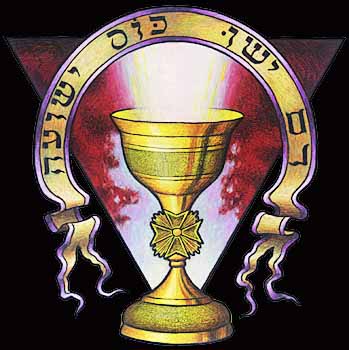 have put the question and received the desired information. But the poet did not live to finish his story, whether the explanation of the Graal, offered by the continuators, is that which Chrestien what the Graal signifies; in his version it has no pronounced religious character. On the other hand, in the Early History versions it is invested with the greatest sanctity. It is explained as the dish from which Christ ate the Paschal lamb with his disciples, which passed into possession of Joseph of Arimathea, and was used by him to gather the Precious Blood of Our Saviour, when His body was taken from the Cross. It becomes identified with the Chalice of the Eucharist. The lance is explained as the one with which Longinus pierced Our Lord's side, and the silver plate becomes the paten covering the chalice. The quest in these versions assumes a mst sacred character, the atmosphere of chivalric adventure in Chrestien's poem yields to a militant asceticism, which insists not only on the purity of the quester, but, in some versions (Queste, Perlesvaus), on his virginity. In the "Queste" and "Grand St. Graal," moreover, the hero is not Perceval but the maiden-knight, Galaad. But the other knights of the Round Table are made to participate in the quest.
have put the question and received the desired information. But the poet did not live to finish his story, whether the explanation of the Graal, offered by the continuators, is that which Chrestien what the Graal signifies; in his version it has no pronounced religious character. On the other hand, in the Early History versions it is invested with the greatest sanctity. It is explained as the dish from which Christ ate the Paschal lamb with his disciples, which passed into possession of Joseph of Arimathea, and was used by him to gather the Precious Blood of Our Saviour, when His body was taken from the Cross. It becomes identified with the Chalice of the Eucharist. The lance is explained as the one with which Longinus pierced Our Lord's side, and the silver plate becomes the paten covering the chalice. The quest in these versions assumes a mst sacred character, the atmosphere of chivalric adventure in Chrestien's poem yields to a militant asceticism, which insists not only on the purity of the quester, but, in some versions (Queste, Perlesvaus), on his virginity. In the "Queste" and "Grand St. Graal," moreover, the hero is not Perceval but the maiden-knight, Galaad. But the other knights of the Round Table are made to participate in the quest. The early history of the Grail is intimately connected with the story of Joseph of Arimathea. When he is cast into prison by the Jews, Christ appears to him and gives him the vessel, through which he is miraculously sustained for forty-two years, until liberated by Vespasian. The Grail is then brought to the West, to Britain, either by Joseph and Josephes, his son (Grand St. Graal), or by Alain one of his kin (Robert de Boron). Galaad (or Perceval) achieves the quest; after the death of its keeper the Grail vanishes. According to the version of the "Perlesvaus" Perceval is removed, no one knows whither, by a ship with white sails on which is displayed a red cross. In the Guiot-Wolfram version we meet with a conception of the Grail wholly different from that of the French romances. Wolfram conceives of it as a precious stone, lapsit exillis (i.e. lapis or lapsi ex caelis?) of special purity, possessing miraculous powers conferred upon it and sustained by a consecrated Host which, on every Good Friday, a dove brings down from heaven and lays down upon it. The angels who remained neutral during the rebellion of Lucifer were its first guardians; then it was brought to earth and entrusted to Titurel, the first Grail king. It is guarded in the splendid castle of Munsalvaesche (mons salvationis or silvaticus?) by itself and nourished by its miraculous food-giving power.
The early history of the Grail is intimately connected with the story of Joseph of Arimathea. When he is cast into prison by the Jews, Christ appears to him and gives him the vessel, through which he is miraculously sustained for forty-two years, until liberated by Vespasian. The Grail is then brought to the West, to Britain, either by Joseph and Josephes, his son (Grand St. Graal), or by Alain one of his kin (Robert de Boron). Galaad (or Perceval) achieves the quest; after the death of its keeper the Grail vanishes. According to the version of the "Perlesvaus" Perceval is removed, no one knows whither, by a ship with white sails on which is displayed a red cross. In the Guiot-Wolfram version we meet with a conception of the Grail wholly different from that of the French romances. Wolfram conceives of it as a precious stone, lapsit exillis (i.e. lapis or lapsi ex caelis?) of special purity, possessing miraculous powers conferred upon it and sustained by a consecrated Host which, on every Good Friday, a dove brings down from heaven and lays down upon it. The angels who remained neutral during the rebellion of Lucifer were its first guardians; then it was brought to earth and entrusted to Titurel, the first Grail king. It is guarded in the splendid castle of Munsalvaesche (mons salvationis or silvaticus?) by itself and nourished by its miraculous food-giving power.The relationship of the Grail versions to each other, especially that of Chrestien to those of Robert de Boron and the "Queste," is a matter of dispute. Nor is their relative chronology certain. But in all these versions the legend appears in an advanced state of development, the preceeding phases of which are not attested by literary monuments, and therefore, can only be conjectured. The origin of the legend is involved in obscurity, and scholars are divided in their views on this point. An Oriental, a Celtic, and a purely Christian origin have been claimed. But the Oriental parallels, like the sun-table of the Ethiopians, the Persian cup of Jamshid, the Hindu paradise, Cridavana, are not very convincing, and Wolfram's statement, that Kyot's source was an Arabic manuscript of Toledo, is open to grave doubt. It is different with the Celtic story. There are undoubtly Celtic elements in the legend as we have it; the Perceval story is probably, and the
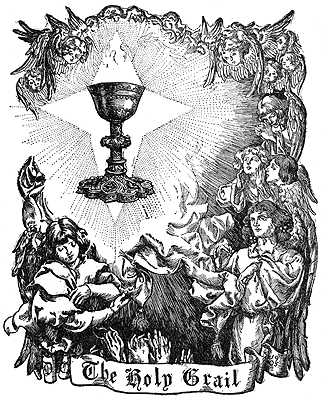 Arthurian legend certainly, of Celtic origin, and both of these legends intimately connected with the quest story. Talismans, such as magic lances and food-giving vessels figure prominently in Celtic myths and folk-tales. According to this theory the "Mabinogion," with its simple story of vengeance by means of talismans and devoid of religious significance, would yield the version nearest to the original form of the legend. Back of the quest-story would be some pre-Christian tale of a hero seeking to avenge the injury done to a kinsman. The religious element would then be of secondary origin, and would have come into the legend when the old vengeance-tale was fused with the legend of Joseph of Arimathea, which is essentially a legend of the conversion of Britain.
Arthurian legend certainly, of Celtic origin, and both of these legends intimately connected with the quest story. Talismans, such as magic lances and food-giving vessels figure prominently in Celtic myths and folk-tales. According to this theory the "Mabinogion," with its simple story of vengeance by means of talismans and devoid of religious significance, would yield the version nearest to the original form of the legend. Back of the quest-story would be some pre-Christian tale of a hero seeking to avenge the injury done to a kinsman. The religious element would then be of secondary origin, and would have come into the legend when the old vengeance-tale was fused with the legend of Joseph of Arimathea, which is essentially a legend of the conversion of Britain.Those who maintain the theory of a purely Christian origin regard the religious element in the story as fundamental and trace the leading motifs to Christian ideas and conceptions. It is derived from the apocryphal Gospel of Nicodemus, which is known to have had a great vogue in the twelfth century, paricularly in Britain. There we read how Joseph, whom the Jews had imprisoned, is miraculously fed by Christ Himself . Additional traits were supplied by the "Vindicta Salvatoris," the legendary account of the destruction of Jerusalem. Furthermore, Joseph was confused with the Jewish historian, Josephus, whose liberation by Titus is narrated by Suetonius. The food-producing properties of the vessel can be explained, without resorting to Celtic
 parallels, by the association of the Grail with the Sacrament of the Eucharist, which gives spiritual nourishment to the faithful. The purely Christian legend which thus had arisen was brought into contact with the traditional evangelization of Britain, and then developed on British soil, in Wales, and thus the Celtic stamp, which it undeniably bears, is accounted for. In connection with the legendary conversion of Britain it is noteworthy that the literary accounts of this event are connected with the famous Abbey of Glastonbury, which is also intimately associated with the legend of Arthur, Glastonbury being identified in William of Malmesbury's account with the mythic Avalon. So scholars are inclined to connect this British sanctuary with the origin of the Grail romances. Possibly Walter Map, who died as Archdeacon of Oxford in 1210, and to whom is ascribed the authorship of a Grail-Lancelot cycle, got his information from that abbey. The first Grail romances was then probably written in Latin and became the basis for the work of Robert de Boron, who was an English knight under King Henry II, and a contemporary of Chrestien and of Map.
parallels, by the association of the Grail with the Sacrament of the Eucharist, which gives spiritual nourishment to the faithful. The purely Christian legend which thus had arisen was brought into contact with the traditional evangelization of Britain, and then developed on British soil, in Wales, and thus the Celtic stamp, which it undeniably bears, is accounted for. In connection with the legendary conversion of Britain it is noteworthy that the literary accounts of this event are connected with the famous Abbey of Glastonbury, which is also intimately associated with the legend of Arthur, Glastonbury being identified in William of Malmesbury's account with the mythic Avalon. So scholars are inclined to connect this British sanctuary with the origin of the Grail romances. Possibly Walter Map, who died as Archdeacon of Oxford in 1210, and to whom is ascribed the authorship of a Grail-Lancelot cycle, got his information from that abbey. The first Grail romances was then probably written in Latin and became the basis for the work of Robert de Boron, who was an English knight under King Henry II, and a contemporary of Chrestien and of Map.The fully developed Grail legend was later on still further connected with other legends, as in Wolfram's poem with that of Lohengrim, the swan-knight, and also with that of Prestor John, the fabled Christian monarch of the East. Here also the story of Klinschor, the magician, was added. After the Renaissance the Grail legend, together with most medieval legends, fell into oblivion, from which it was rescued when the Romantic movement set in at the beginning of the nineteenth century. The most famous modern versions are Tennyson's "Holy Grail" in the "Idylls of the King" (1869), and Wagner's music
 -drama, the festival-play, "Parsifal," produced for the first time at Bayreuth in 1882.
-drama, the festival-play, "Parsifal," produced for the first time at Bayreuth in 1882.A word as to the attitude of the Church towards the legend. It would seem that a legend so distinctively Christian would find favour with the Church. Yet this was not the case. Excepting Helinandus, clerical writers do not mention the Grail, and the Church ignored the legend completely. After all, the legend contained the elements of which the Church could not approve. Its sources are in apocryphal, not in canonical, scripture, and the claims of sanctity made for the Grail were refuted by their very extravagance. Moreover, the legend claimed for the Church in Britain an origin well nigh as illustrious as that of the Church of Rome, and independent of Rome. It was thus calculated to encourage and to foster any separatist tendencies that might exist in Britain. As we have seen, the whole tradition concerning the Grail is of late origin and on many points at variance with historical truth.
The "Queste" was edited by Furnivall, "La Queste del Saint Graal" (Roxburghe Club, London, 1864), also the Grand St. Graal under the title "Seynt Graal or the Sank Ryal", etc. (Roxburghe Club, London, 1861-63). The Perlesvaus is in Potvin's edition of Chrestien, I (Mons, 1866); the Didot Perceval in Hucher, "Le Saint Graal" (Le Mans, 1874-78). Robert de Boron's poem was edited by Michel, "Le roman du St. Graal" (Bordeaux, 1841), Malory's "Morte D'Arthur" by Sommer (London, 1889-91), and the Perlesvaus rendered into English by Evans, "The High History of the Holy Grail" (London, 1898).
1) A DESCRIPTION
The Holy Grail is, 17 cm high, and is formed by a cup, the body (fust) and the foot or base.
The cup, carved out of a big piece of agate, is 9 cm. in diameter. The body composed of: a) a centred hexagonal column with a round nut in the middle and topped by two small plates, the upper one holding the holy chalice and the lower one supporting the whole base structure; b) two lateral snake shaped handles, hexagonally carved, and c) the garniture of the base, is all of gold.
The base is set with 28 pea-sized pearls, two balaxes and two emeralds. The rest of the body is finely carved.
 The foot or base is composed by an elliptical cup of chalcedony (the same material as the cup). An inscription is engraved on its back which was first read and publicised by the archaeologist Antonio Beltran.
The foot or base is composed by an elliptical cup of chalcedony (the same material as the cup). An inscription is engraved on its back which was first read and publicised by the archaeologist Antonio Beltran.2) VALUE OF THE ARCHEOLOGICAL DATA
The cup is a very ancient work and nothing can be said against the idea that it was utilized by the Lord during the first Eucharistic consecration.
The base is as well a very old cup. Perhaps a further study on the inscription could give be a better understanding.
It seems that the body contains elements and remembrances of on older antiquity which during the Middle Age were transformed specially on the base setting, at the end of XIV century.
3) HISTORY
According to some documents, it is evident that the Holy Grail stood at Saint. Juan de la Pena Monastery, at least in 1399. On September 26 of the same year, King Martin the Human brought it to the chapel of the Royal Palace at the Alfajeria in Zaragoza (Aragon Crown Archives, Barcelona Collection Martin el Humano, Parchment, 136).
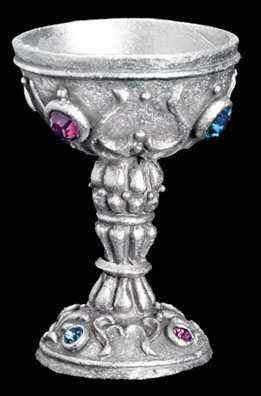
Upon the King's death, in September 1410, is was found in the inventory of his properties in Barcelona.
In Valencia, Martin V's successor. Alphonse V el Magnanimo, transferred it to his Valencia Royal Palace about 1424.
His brother, Dan Juan, King of Navarra, presented it to the Valencia Cathedral on March 14, 1437 (Cathedral Archives, volume 3.532, page 36 v - 37 v).
From the Valencia Cathedral it was taken out only two times: during the Independence War (March 1809 to September 1813). It was moved to Alicante and then to the towns of Ibiza and Palma de Mallorca, fleeing from possible plundering.
At the National Uprising (July 21, 1936 to April 9, 1939) it was hidden in Valencia and also in the village of Carlet, thus escaping from destruction or loss.
4) PROTOHISTORY
From archaeological and literary evidence, it may be assured that the Holy Grail was brought to the Saint Juan de la Pena Monastery on occasion of the Roman Liturgy being adopted. According to a decree of 14th December 1134 transferred to us by an anonymous writer, it was there at the time.
Formerly (from 1071 to 1063) it probably remained at the Jaca Cathedral. On the Sixtus capitol of this Cathedral there exists a mark.
It is assumed that between 1063 and 1073 it pilgrimaged, together with the Court and See of Aragon, through Bailo, Santa Maria de Sasabe (today Saint Adrian), Siresa and Yebra.
The word Grail is derived not from Latin <
5) PREHISTORY
From 713 to 258, probably the date of its arrival in Huesca, there exists only a firm

This legend has always asserted that: a) the Holy Grail was sent to Huesca by Saint Lawrence, First Deacon of the Roman Church, b) whilst in Rome it was the Papal Chalice, beginning with Saint Peter and ending with Sixtus II.
These assertions appear to conform to a notably valuable document: the Mass Canon. It is known that the Canon is the old Pope's canon. The Popes, when taking the Holy Chalice for the consecration said: <
It is believed therefore that they consecrated in the same Last Supper Chalice. This being true, the remaining things offer some difficulties. From the Cenacle of Jerusalem, it would have been transferred to Rome by Saint Peter and his faithful Saint Marcus, whose family, according to the old tradition, now preserved by records, owned the house where the Last Supper was celebrated.
No comments:
Post a Comment